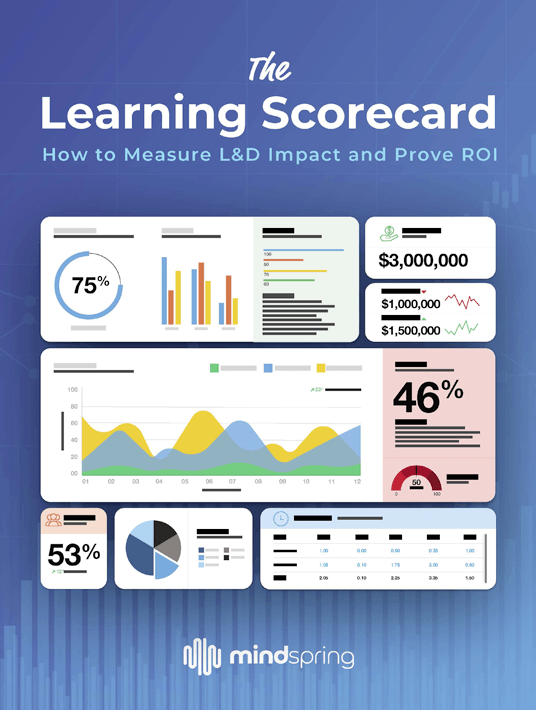How Do You Evaluate The Costs And Benefits Of Learning?
This article is part of a series on tracking the right metrics using the right methodology to visually display and quantify the investment in learning and prove ROI. What you are about to read is a fable. The company, AshCom, is fictional, but the learning challenges faced by Kathryn, AshCom’s CLO, and her team are real and commonly shared by learning teams in large organizations. It is our hope that you will be able to connect with the characters, their challenges, and the solutions they discover. We also invite you to read the first eBook in the series.

Financial Metrics Flashing Yellow
"People who have goals succeed because they know where they’re going." Kurtis’ grandfather had written these words at the bottom of his high school graduation card. Kurtis had kept the card and followed his advice.
Kurtis had a plan for his career, even as a young man. Soon after college, where he majored in finance, he decided he wanted to be the Chief Financial Officer of a large company. Numbers made sense to him. They could not only tell him what had happened but also gave him insight into what was to come. Numbers told stories about the health of a firm. To achieve his objective, Kurtis prepared for and passed the CPA exam while completing an MBA at the Carlson School of Management at the University of Minnesota.
With his education and certification complete, Kurtis took a series of jobs that would lead him to the job he really wanted. He spent some time on the finance team of a large retailer. There he learned to manage cash and risk. His next move was to a smaller manufacturer where he served as the controller. The financial pie might have been a lot smaller, but he oversaw a large slice of it. After several years, he saw a position become available at AshCom for its CFO. He was a perfect fit. He was coming from manufacturing and had a strong financial background.
AshCom had 7,000 employees in multiple plants spread around the United States. His job was intense and demanding, but he enjoyed the pressure. After seven years at AshCom, Kurtis believed he had seen most of what would come at him. Most new challenges were some version of challenges he had already seen.
AshCom was conservative. It was a well-established company with deep experience and knowledge in manufacturing. It did not experience wild swings in its financials. Most changes were incremental.
Recently, Kurtis noticed a few financial metrics flashing yellow. There was no single thing causing profitability to drop. It was more like a series of factors. The number of AshCom’s competitors was growing. They were also getting more efficient through automation. AshCom was intentional about not falling behind in the use of technology, but it seemed that its competitors, new and old, were investing heavily in IT and robotics.
Putting Pressure On Profitability
But this was not the only pressure. Rising wages were putting pressure on profitability. It was becoming more challenging to retain good employees. It was even more difficult to attract new talent. It seemed that young people were not particularly interested in careers in manufacturing, which only deepened the challenge.
Further adding to the challenge was the rise in the cost of raw materials. More competitors meant more companies competing for a limited pool of materials needed for manufacturing.
None of these problems were new, but they were all coming to a head at the same time. Then something happened that had not happened in Kurtis’ seven-year tenure at AshCom. The company lost money.
This had happened before when AshCom had invested heavily in something new, but that was not the case here. And when they did have a loss, it was usually limited to a month. Worst case, it was two months. But the C-Suite had often anticipated it because of the investments they made. They knew it would be short-lived.
That was not this situation. AshCom lost money in its second fiscal quarter. This set off alarm bells among the leadership team. They had never had a loss over an entire quarter, at least not in recent memory. A lot of eyes were now on weekly performance numbers, which were not improving.
Three months of losses were unsettling. When the losses extended into the fifth month, it looked like AshCom would lose money for two straight quarters. Unthinkable.
The C-Suite leaders were now in almost daily meetings to discuss what was happening. They could not point at one thing that was causing the difficulty. It was several things in tandem. No one was pointing fingers, something Kurtis was thankful for. They worked as a team to come up with a plan to right the ship. They would also look for places where the AshCom ship had sprung small leaks.
Death By A Thousand Pecking Ducks
Kurtis had a saying that many people at AshCom were familiar with: “Shavings make a pile.” In other words, small expenditures might look inconsequential on their own, but they added up over time. Kurtis was convinced this was part of the problem. Inefficiency had crept into their systems, and they hadn’t noticed. The CEO referred to it as being pecked to death by a thousand ducks, an expression that made some laugh and some cringe.
The C-Suite, made up of the CEO, the CFO, the CHRO, and the COO, came up with a plan. They would look at everything and every process in operations, human relations, and finances. Nothing was off the table. They committed to finding each and every duck.
Everything would be examined looking for inefficiencies. They were also determined to find the return on investment (ROI) for every activity. Things that could not be demonstrated to show a return would be eliminated. It was an aggressive plan.
They decided to give the plan a name and settled on “Defend the Spend.” Every expense would be considered from the perspective of how it contributed to the financial performance of the company. When this was announced, it caused significant stress throughout the company. The C-Suite leaders knew this was going to happen. They were trying to walk a fine line between raising awareness and maintaining calm. By and large, it worked, although some team members felt the stress more than others.
Daily Morning Meetings
Laszlo, the Chief Operating Officer, and Kurtis, the Chief Financial Officer, started to meet for an hour every morning. They began with a list of all the activities they oversaw and then worked through them from both an operational and a financial perspective. They were specifically looking for places and processes that were not working as they should have been financially. They were hunting for ducks.
One of the first ducks they located was preventative maintenance. It wasn’t an obvious place to look. Actually, it would normally be one of the last places they would look. But this special attention brought problems to the surface almost immediately. Laszlo was somewhat embarrassed that he hadn’t considered it earlier.
Preventative maintenance losses were sneaky. One might even say hidden. As Laszlo and Kurtis dug into the topic, they began to build a list of items where money was leaked because of poorly performed preventative maintenance. The list was longer than either of them anticipated.
They began with the easy items like scheduled machine uptime and scheduled machine downtime for things like maintenance and training. Laszlo was aware that machines were not working at their productivity goals. He assumed it was an operator error. It turned out that it had more to do with maintenance being done properly.
Scheduled lubrication and repairs were not being done which lowered parts produced per hour and shortened the life cycle of the machines. Spare parts that should have been on hand were never ordered and had to be expedited when something broke. Not only were they paying a premium for the parts and shipping, but the machine also sat idle while waiting for the part.
Laszlo and Kurtis looked at the energy costs of new machines versus older machines that had not been properly maintained. The difference was significant. Laszlo reminded Kurtis that shavings like this do make a big pile over time.
Calculating Every Cost
They covered other topics like looking at the scrap rate of properly maintained machines versus those that were not being maintained. Scrap is waste, they both knew, and waste is incredibly expensive. Although there were no incidents yet, Laszlo knew that poorly maintained machines are also the most dangerous and would, at some point, cause an injury.
When they had listed all the ways that poor preventative maintenance was contributing to the financial pressures they were facing, Kurtis had a question.
“I don’t mean to point fingers,” Kurtis said, “but what is the root cause of all this? It is certainly hurting our finances and contributing to our losses—more than what I realized. Why is this happening? Is it because we don’t have the correct procedures in place?”
Laszlo responded, “That’s a good question, and I don’t take any offense. I want to get this solved. Sometimes my team is so focused on getting product out the door that we forget to pay attention to things like preventative maintenance.”
“So, they know what to do,” asked Kurtis, “but they aren’t doing it?”
“Maybe,” said Laszlo. “But I suspect we haven’t done a good job training them on what to do. We haven’t made it a priority. And I suspect they don’t really know the long-term effects of what happens when we don’t.”
“Then this is a training and perspective problem?” asked Kurtis.
“I think so,” replied Laszlo. “We have the right schedules and priorities. We just aren’t living up to them.”
“Then I know what to do,” said Kurtis.
He had in mind to talk to Kathryn, the Chief Learning Officer. Kurtis needed to meet with her anyway on the “Defend the Spend” initiative, something he knew would make her uncomfortable. They had already discussed the challenge of demonstrating ROI in learning. He knew something of how hard the impact of learning was to actually prove.
Now he had two topics to discuss with Kathryn. First, how her learning team could build a learning experience that would greatly improve preventative maintenance performance. And second, how she would measure the costs and benefits of that program.
The preventative maintenance learning would be in Kathryn’s wheelhouse. But he knew the second topic would likely be an uncomfortable conversation. He sent an email to Kathryn immediately after his time with Laszlo asking when she was available.
Conclusion
Download the eBook The Learning Scorecard: How To Measure L&D Impact And Prove ROI to delve into the data and discover which key metrics your L&D team should consider. You can also join the webinar to discover a completely new approach to measuring ROI.
Dear Reader, if you would like to see a demo of MindSpring’s Learning Scorecard, please click here to schedule a time convenient for you and the learning experts at MindSpring will be happy to walk you through it.


